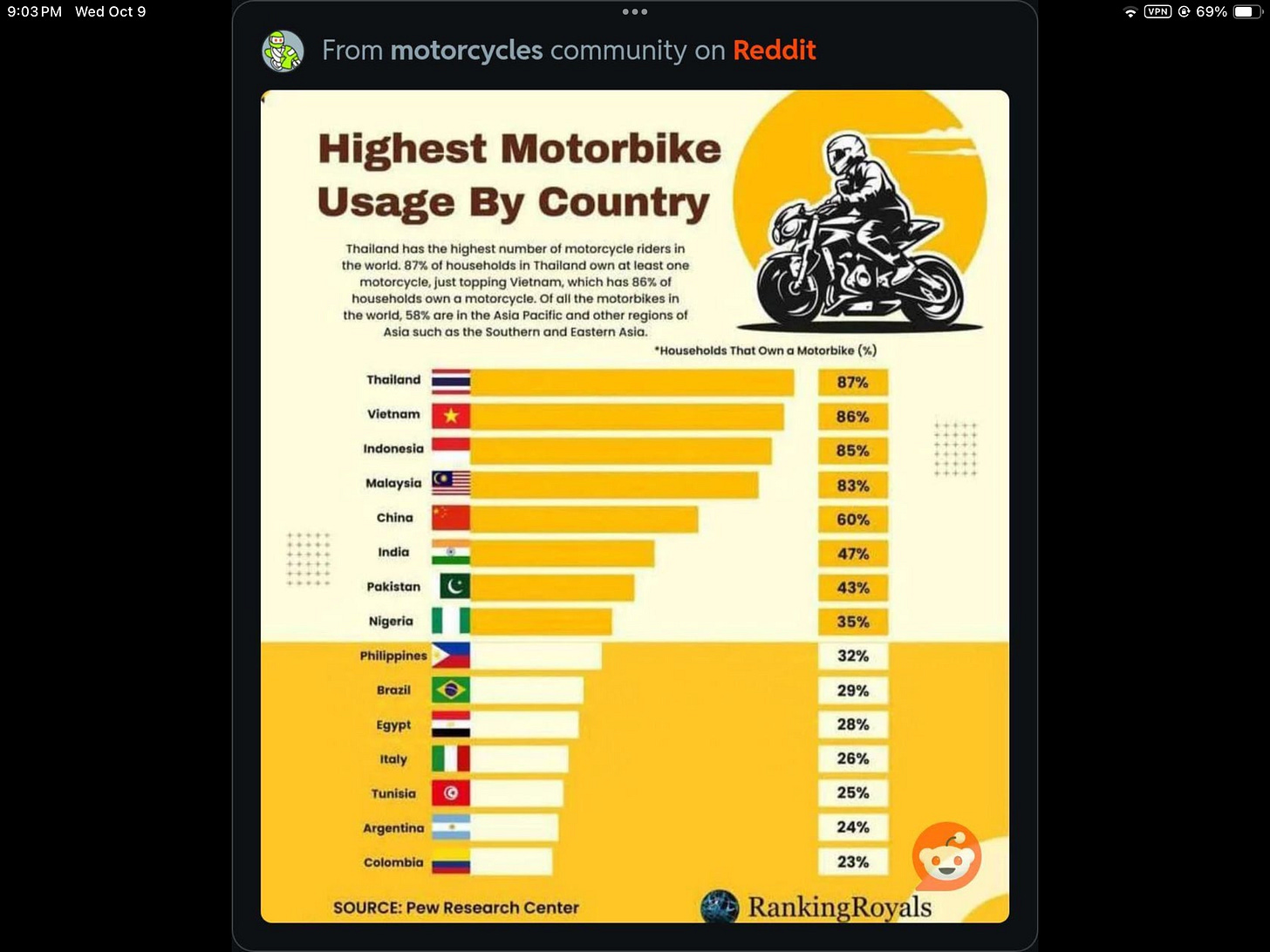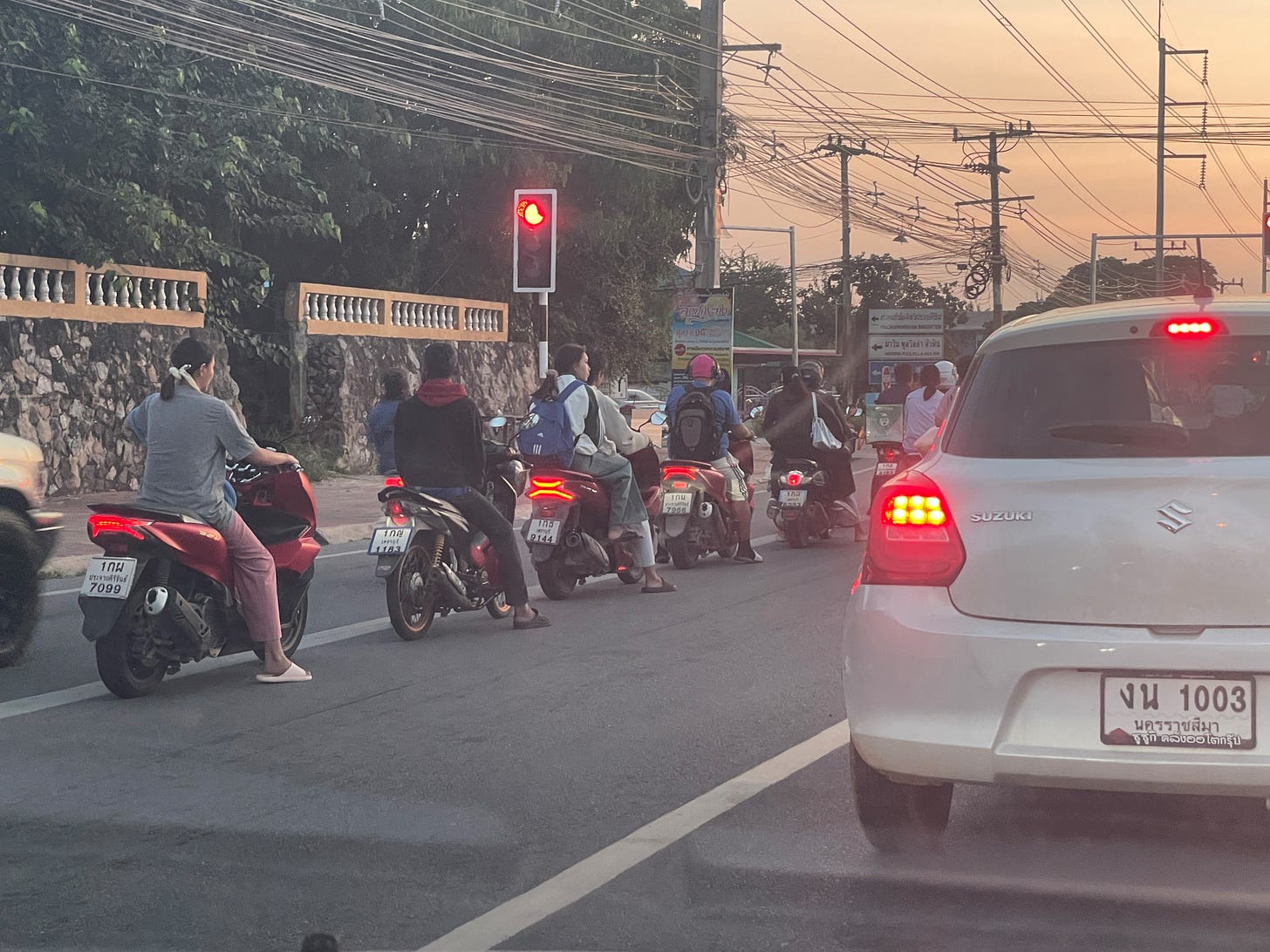Ah, Thailand —a country where every road is an adventure and every motorbike is a potential co-star in the grand traffic ballet. Driving here is a rite of passage, an exercise in patience, and, occasionally, a test of nerve. In Thailand, people practice tolerance, patience, creativity, and, yes, forgiveness, and the only rule is – don’t crash into anybody.
For instance, there seems to be a neverending competition to see how many people you can cram on your bike. Sometimes it is just one person, but often it’s 3 and I’ve seen 5 or 6 people (and a dog or two) balanced on these two-wheeled transport titans.
For every car you see on the road, there must be at least a hundred motorbikes zipping around like they have places to be. As a recent post on Reddit pointed out, Thailand is the place to be if you want to travel around on a powered set of two wheels.
Here, motorbikes come in all shapes, sizes, and carrying capacities. Some are built to be modern packhorses.
But mostly, its just the most popular form of transport, taking people to work, to school, to shop, to eat. You can even order a taxi in the form of a motorbike - an experience I have so far avoided…

If you’re used to driving in a place like New York City, where the horn is an extension of the human hand, brace yourself: here, horn use is as rare as a unicorn sighting. In three months, I’ve heard exactly two car horns. One of those was me. Cars here are remarkably polite and silent. Motorbikes, though, have their own version of communication: a soft, quick beep, usually right when they’re sitting in your blind spot. It’s their way of saying, “I’m here, don’t make any sudden moves,” or sometimes, “Just so you know, I’m coming whether you like it or not.”
Then there are the U-turns. In Thailand, U-turns are less an occasional necessity and more a way of life. No, I mean it—if you haven’t done at least five U-turns on a single trip, did you even drive today? And they’re not usually neatly organized with dedicated lanes like you might find elsewhere. Oh, no. These U-turns happen anywhere the driver feels inspired. You want to turn around in the middle of a four-lane road with traffic hurtling toward you? Go for it. Here, you just take a breath, commit, and hope everyone else is paying attention.
While the traffic lights are mostly obeyed, the rest of the signs are more… suggestions. Stop signs, yield signs, lane markings—they’re all open to interpretation. I once saw a roundabout where cars, motorbikes, and even a few pedestrians created their own special choreography. Everyone took a different direction and miraculously made it out. This system—if you can call it that—might look chaotic, but there’s a hidden order to it. Somehow, it works. Everyone moves with a kind of organized recklessness that only occasionally results in a minor scratch or, as I like to think of it, a badge of driving honor.
For those accustomed to driving on the right side of the road, Thailand throws in an extra curveball by having everyone drive on the left. This sounds simple enough, until you realize it means the steering wheel is also on the right, and you’re shifting with your left hand. Oh, and every instinct you’ve spent a lifetime cultivating about which way to look first at an intersection? Throw that out the window. Or, at least, try to relearn it before you accidentally look left and step into a horde of scooters coming from the right. I’ve spent a decent amount of my life driving on the “other” side, but I’ve had to adapt my perspective here. Patience is critical, but so is the concept of “owning your space.” Get your vehicle’s nose into the next gap or you could be sitting for a very long time.
On a related note, one of the quirkiest adjustments for drivers from the U.S. is that while most of the controls are where you’d expect them to be, the turn signal switch is on the right side of the steering wheel, not the left. This seemingly minor change has led to some entertaining moments. For my first two weeks back in Thailand from the U.S., I often ended up turning on the windshield wipers when I meant to signal. It’s a guaranteed way to confuse the drivers around you: a sudden, vigorous wipe of the windshield instead of the customary flash of the indicator. Just when I’ve got it down here in Thailand, I’ll head back to the States and spend another two weeks signaling left turns with my wipers. Ironically, the Thais use their turn signals quite a bit more than I’m used to seeing in North Carolina. In Thailand, it’s not just courtesy; it’s a way to give the many motorbikes and cars around you a chance to stay clear. So I’ve had to get on board with using it, even if it sometimes leads to the whole car being “cleared for takeoff” by my errant wipers.
The roads here are a mixed bag too. On one end of the spectrum, you’ve got modern, divided highways, complete with toll booths and limited access ramps. On the other, you’ll find two-way roads that look wide enough for a car, but when you throw in the odd street vendor, a few motorbikes, and the occasional wandering dog, things start to feel a bit more snug. Some of these roads narrow to the point where you have to decide if your side mirror is a necessity or a luxury you can live without.
Apple Maps does a pretty decent job guiding you around, but you quickly learn that local knowledge is invaluable. Maps may know the fastest route, but they don’t know which roads will transform into outdoor markets on certain afternoons or where a horse or two might take their afternoon stroll. To drive here successfully, you need a seasoned friend or a few weeks of trial and error. Otherwise, you’ll find yourself in situations Apple Maps never prepared you for—like being told to go straight on a road that’s been completely overtaken by a lively game of football.
There’s a delightful unpredictability here, one that keeps you alert, to say the least. I've learned that driving in Hua Hin isn’t just about getting from A to B. It’s a team effort. It’s me, my car, my fellow motorists (the ones I can see and the ones hidden in my blind spots), and the ever-watchful street dogs—all of us working together to navigate this quirky little town with its unwritten rules.
For expats new to Thailand, driving may feel like a fever dream of road adventures, horn-less traffic, and moments of “Did that really just happen?” But somehow, once you stop fighting it and go with the flow, the chaos begins to make sense. It may not be orderly, but it has a rhythm all its own. And in that rhythm, you start to see the beauty of it all—the trust in other drivers, the tacit understanding that we’re all just doing our best, and the shared experience of traveling a road less managed.
So, the next time you’re behind the wheel in Thailand, remember: it’s not about getting there fast, or even getting there in one piece (though that helps). It’s about embracing the ride, enjoying the little quirks, patience, and yes, learning to love the U-turn.









I had all the same challenges driving in England, plus many of the country roads are literally one lane and bracketed by impenetrable hedgerows. Scary stuff when going around a curve!
Thank you for the ride Rick! Your storytelling skills are exceptional and you took me to a far away place for an enjoyable experience. Keep the stories coming please! Be safe, have fun, and continue the carpe diem my friend.